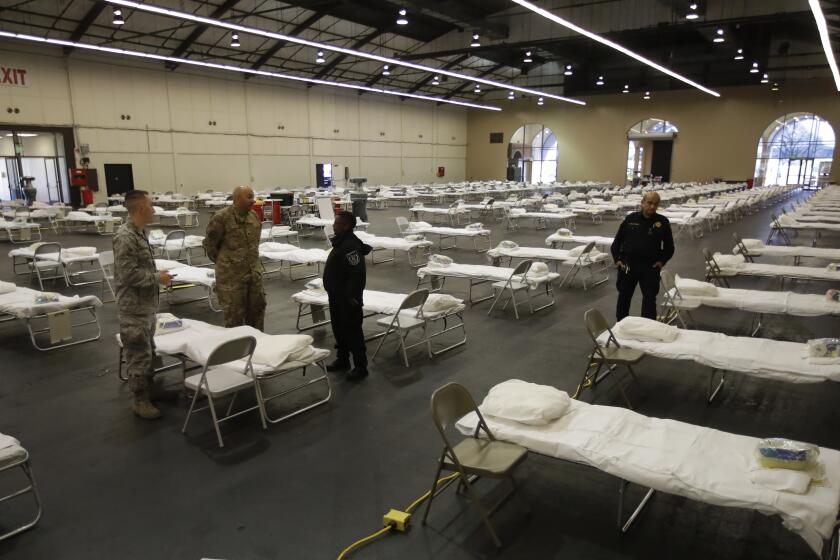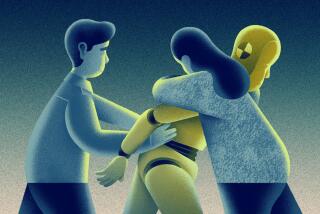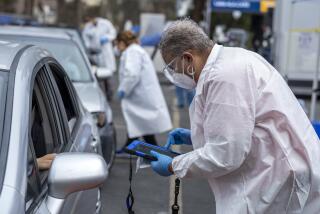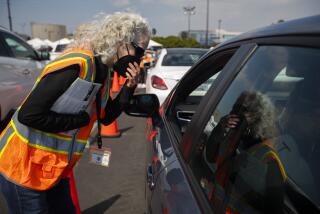Opinion: I just hugged my daughter for the first time in 18 days. Is this our new normal?
- Share via
Remember when the biggest concern over shaking someone’s hand was whether or not it was clammy?
When we Californians developed the first inklings of coronavirus concern — eons ago, maybe even more than a month — elbow bumps and little waves from afar felt like a temporary and almost humorous adjustment in our lives.
How quickly we have adapted to alarming new norms.
When I watched old “Ozark” episodes last week, prepping for the premiere of the third season, I was shocked and agitated by the characters’ continual breaking of the rules of social distancing — living their innocent, COVID-less lives of … 2018.
They were having dinner parties with new neighbors. Crowding into bars. Hugging friends. Sharing hip flasks. I would jump a little each time, ready to admonish them: “Wait, stop! There’s way too much crowding in that gentlemen’s club. Where’s your sanitizer? Marty, do NOT shake hands with Jacob; you don’t know if he’s safe!” (Actually, that last one was probably good advice in any case.)
The 11 states that are still foolishly acting as if the coronavirus isn’t a problem.
“Tiger King” feels downright ancient. All those people, huddled on benches, waiting for their turn to pet tiger cubs, clearly living in a long-ago age in which no one wondered whether they could spread disease by stroking a kitty. No one mentioning even the slightest fear of life without toilet paper.
On “The Good Doctor,” protective masks and gowns are worn and discarded with abandon.
What was normal such a short time ago now presents as reckless.
Perhaps we shouldn’t be surprised by this sudden shift in perception. An experiment with rats performed nearly 80 years ago showed that they learned how to run a maze faster when they were punished with shocks than when they were rewarded with food.
Our own sense of awareness is similarly heightened by anxiety. Even the prospect of forbidden closeness carries an implicit shock: the possibility that we might start dry coughing in the days to come.
If the same lesson holds true for our post-crisis future, it will probably take longer for us to feel safe socializing in our old patterns once again. The negative reinforcement, we hope, will be gone — or so minimal that we no longer worry continually. But the undercurrent of fear will probably remain long after the shocks of daily case totals are gone.
How soon will the reward of an afternoon spent in a café, or a dinner for the extended family, teach us to trust again? Some of our social reticence might stay with us forever. After all, handshakes were germy affairs long before the days of the novel coronavirus.
Three weeks ago, my adult daughter flew in from Chicago to stay through the frightening days ahead. She followed an elaborate protocol for keeping safe on the plane. We had even more planned-out procedures in place for the car ride from LAX and her entry into the house. Then came the dance of distancing and hygiene: We spent limited time in the same room; no one used seating that someone else had used. We had assigned bathrooms and surfaces for working and eating and became adept at turning switches on and off with our elbows. When in the same room, the six-foot distances ruled. It was OK, she and I told each other. We weren’t aching for our usual affectionate relationship. We sat outside together and practiced drawing.
That went on for 18 symptom-free days (we hadn’t yet learned how many COVID-19 cases are symptomless).
Finally, we hugged.
And I wept because I had stopped even realizing how badly I wanted that hug.
More to Read
A cure for the common opinion
Get thought-provoking perspectives with our weekly newsletter.
You may occasionally receive promotional content from the Los Angeles Times.












